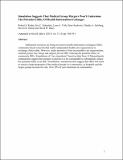Simulation Suggests That Medical Group Mergers Won't Undermine The Potential Utility Of Health Information Exchanges
Author(s)
Rudin, Robert S.; Schneider, Eric C.; Volk, Lynn A.; Szolovits, Peter; Salzberg, Claudia A.; Simon, Steven R.; Bates, David W.; ... Show more Show less
DownloadRudin-Simulation-HA-all.pdf (396.7Kb)
OPEN_ACCESS_POLICY
Open Access Policy
Creative Commons Attribution-Noncommercial-Share Alike
Terms of use
Metadata
Show full item recordAbstract
Federal and state agencies are investing substantial resources in the creation of community health information exchanges, which are consortia that enable independent health care organizations to exchange clinical data. However, under pressure to form accountable care organizations, medical groups may merge and support private health information exchanges. Such activity could reduce the potential utility of community exchanges—that is, the exchanges’ capacity to share patient data across hospitals and physician practices that are independent. Simulations of care transitions based on data from ten Massachusetts communities suggest that there would have to be many such mergers to undermine the potential utility of health information exchanges. At the same time, because hospitals and the largest medical groups account for only 10–20 percent of care transitions in a community, information exchanges will still need to recruit a large proportion of the medical groups in a given community for the exchanges to maintain their usefulness in fostering information exchange across independent providers.
Date issued
2012-03Department
Massachusetts Institute of Technology. Department of Electrical Engineering and Computer Science; Massachusetts Institute of Technology. Engineering Systems DivisionJournal
Health Affairs
Publisher
Project HOPE
Citation
Rudin, R. S., E. C. Schneider, L. A. Volk, P. Szolovits, C. A. Salzberg, S. R. Simon, and D. W. Bates. Simulation Suggests That Medical Group Mergers Won t Undermine The Potential Utility Of Health Information Exchanges. Health Affairs 31, no. 3 (March 5, 2012): 548-559.
Version: Original manuscript
ISSN
0278-2715
1544-5208